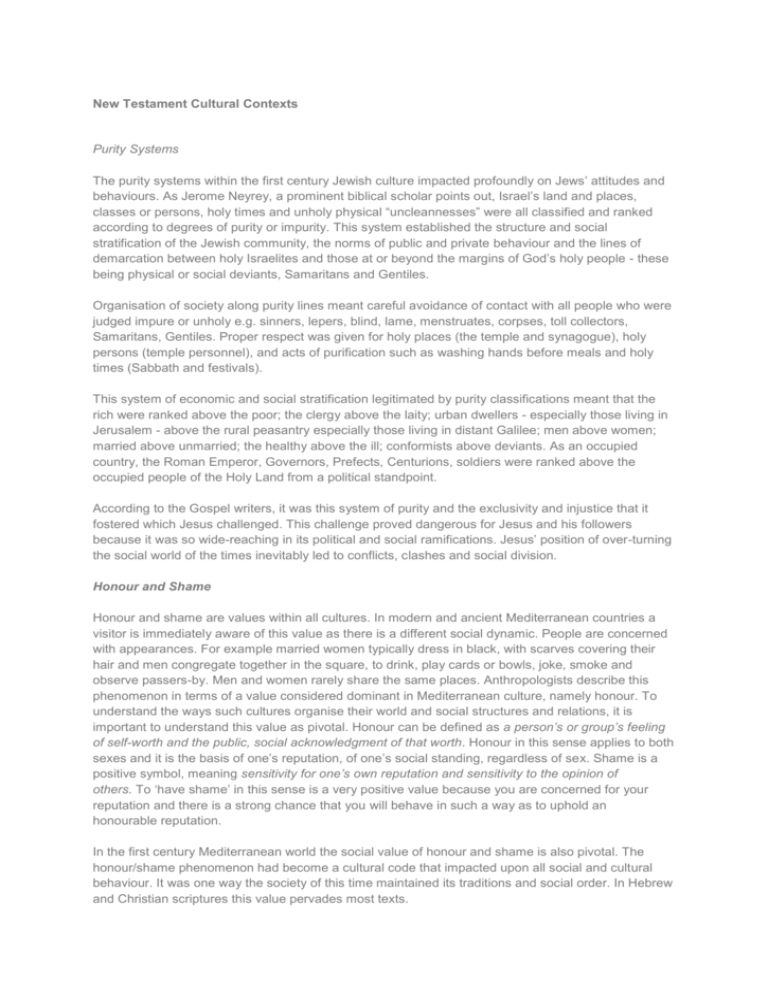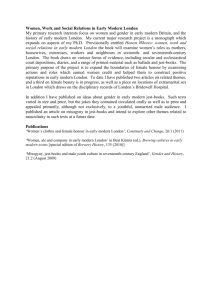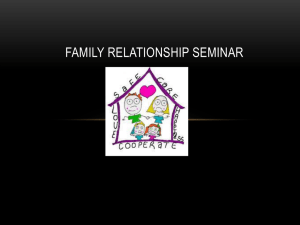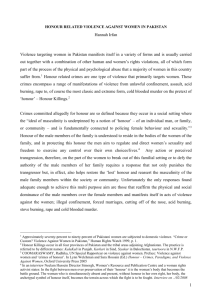Read more
advertisement

New Testament Cultural Contexts Purity Systems The purity systems within the first century Jewish culture impacted profoundly on Jews’ attitudes and behaviours. As Jerome Neyrey, a prominent biblical scholar points out, Israel’s land and places, classes or persons, holy times and unholy physical “uncleannesses” were all classified and ranked according to degrees of purity or impurity. This system established the structure and social stratification of the Jewish community, the norms of public and private behaviour and the lines of demarcation between holy Israelites and those at or beyond the margins of God’s holy people - these being physical or social deviants, Samaritans and Gentiles. Organisation of society along purity lines meant careful avoidance of contact with all people who were judged impure or unholy e.g. sinners, lepers, blind, lame, menstruates, corpses, toll collectors, Samaritans, Gentiles. Proper respect was given for holy places (the temple and synagogue), holy persons (temple personnel), and acts of purification such as washing hands before meals and holy times (Sabbath and festivals). This system of economic and social stratification legitimated by purity classifications meant that the rich were ranked above the poor; the clergy above the laity; urban dwellers - especially those living in Jerusalem - above the rural peasantry especially those living in distant Galilee; men above women; married above unmarried; the healthy above the ill; conformists above deviants. As an occupied country, the Roman Emperor, Governors, Prefects, Centurions, soldiers were ranked above the occupied people of the Holy Land from a political standpoint. According to the Gospel writers, it was this system of purity and the exclusivity and injustice that it fostered which Jesus challenged. This challenge proved dangerous for Jesus and his followers because it was so wide-reaching in its political and social ramifications. Jesus’ position of over-turning the social world of the times inevitably led to conflicts, clashes and social division. Honour and Shame Honour and shame are values within all cultures. In modern and ancient Mediterranean countries a visitor is immediately aware of this value as there is a different social dynamic. People are concerned with appearances. For example married women typically dress in black, with scarves covering their hair and men congregate together in the square, to drink, play cards or bowls, joke, smoke and observe passers-by. Men and women rarely share the same places. Anthropologists describe this phenomenon in terms of a value considered dominant in Mediterranean culture, namely honour. To understand the ways such cultures organise their world and social structures and relations, it is important to understand this value as pivotal. Honour can be defined as a person’s or group’s feeling of self-worth and the public, social acknowledgment of that worth. Honour in this sense applies to both sexes and it is the basis of one’s reputation, of one’s social standing, regardless of sex. Shame is a positive symbol, meaning sensitivity for one’s own reputation and sensitivity to the opinion of others. To ‘have shame’ in this sense is a very positive value because you are concerned for your reputation and there is a strong chance that you will behave in such a way as to uphold an honourable reputation. In the first century Mediterranean world the social value of honour and shame is also pivotal. The honour/shame phenomenon had become a cultural code that impacted upon all social and cultural behaviour. It was one way the society of this time maintained its traditions and social order. In Hebrew and Christian scriptures this value pervades most texts. The sources of honour in this world were ascribed or acquired. Ascribed honour happens to a person passively through birth, family connections, or endowment by notable persons of power. Honour in this case is like inherited wealth. Acquired honour, which is either honourable or dishonourable, is actively sought and achieved - usually at the expense of equals in the social contest. The social context is called ‘Challenge - Riposte’. Challenge - Riposte Challenge - Riposte describes a constant social tug of war in the first century Mediterranean world. It involved a public, rhetorical interaction between two people. Someone would challenge another person in terms of some action (word, deed, or both). The receiver of the verbal and or physical reaction would gain a perception of the intention of the message, as would those listening and observing in the public arena. Finally there would be a reaction by the receiving individual and the evaluation of this reaction on the part of the public. The result of the interactive duel would be either riposte (honour) or a loss of honour. The gospel stories frequently exhibit this interactive social tug of war game between Jesus and others who were seeking to dishonour him. Jesus likewise uses this interactive technique in the public domain to do likewise and to teach about his vision of the reign of God. Gender-Based Place and Roles Men in this time directed their attention outwardly, away from the home; women looked inwardly to the home and to places and things germane to it, such as the well or the grinding wheel. Men are usually aggressive and concerned with authority and precedence, whilst women are guardians of the family honour. These first century Mediterranean societies are clearly patriarchal. A woman when she marries, moves to her husband’s house and becomes embedded in that new kinship group. She moves from one male protector - her father - to another - her husband. If a woman appearing in scripture is not identified as the wife of someone, the reader could wonder as to her ‘shame’. In many gospel stories, Jesus is seen to ignore the stereotypical roles and places of women. He challenges the ways of his own culture many times through his liberal and compassionate treatment of and association with, women.


![honour in Chronicle_Of_a_Death_Foretold[1]](http://s2.studylib.net/store/data/005450529_1-aa8ce11aa8a68b42535f264bd9936daa-300x300.png)

![Australia – Canada: Dairy [DOCX 17 KB]](http://s3.studylib.net/store/data/006700816_1-f58453dc1e2340d3fc0dc0e5674090e4-300x300.png)







